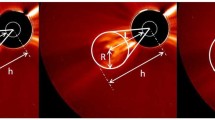Abstract
Observations carried out from the coronagraphs on board space missions (LASCO/SOHO, Solar Maximum and Skylab) and ground-based facilities (HAO/Mauna Loa Observatory) show that coronal mass ejections (CMEs) can be classified into two classes based on their kinematics evolution. These two classes of CMEs are so-called fast and slow CMEs. The fast CME starts with a high initial speed that remains more or less constant; it is also called the constant-speed CME. On the other hand, the slow CME starts with a low initial speed, but shows a gradual acceleration; it is also called the accelerated and slow CME. Low and Zhang [Astrophys. J. 564, L53–L56, 2002] suggested that these two classes of CMEs could be a result of a difference in the initial topology of the magnetic fields associated with the underlying quiescent prominences. A normal prominence magnetic field topology will lead to a fast CME, while an inverse quiescent prominence results in a slow CME, because of the nature of the magnetic reconnection processes. In a recent study given by Wu et al. [Solar Phys. 225, 157–175, 2004], it was shown that an inverse quiescent prominence magnetic topology also could produce a fast CME. In this study, we perform a numerical MHD simulation for CMEs occurring in both normal and inverse quiescent prominence magnetic topology. This study demonstrates three major physical processes responsible for destabilization of these two types of prominence magnetic field topologies that can launch CMEs. These three initiation processes are identical to those used by Wu et al. [Solar Phys. 225, 157–175, 2004]. The simulations show that both fast and slow CMEs can be initiated from these two different types of magnetic topologies. However, the normal quiescent prominence magnetic topology does show the possibility for launching a reconnection island (or secondary O-line) that might be thought of as a “CME’’.
Similar content being viewed by others
References
Amari, T., Luciani, J. F., Mikić, Z., and Linker, J.: 2000, Astrophys. J. 529, L49–52.
Andrews, M. D., and Howard, R. A.: 2001, Space Sci. Rev. 95, 147–163.
Antiochos, S. K., DeVore, C. R., and Klimchuk, J. A.: 1999, Astrophys. J. 510, 485–493.
Guo, W. P., Wu, S. T., and Tandberg-Hanssen, E.: 1996, Astrophys. J. 469, 944–953.
Low, B. C., and Zhang, M.: 2002, Astrophys. J. 564, L53–56.
MacNeice, P., Antiochos, S. K., Phillips, A. Spicer, D. S., Devore, C. R., and Olson, K.: 2004, Astrophys. J. 614, 1028–1041.
MacQueen, R. M., and Fisher, R. R.: 1983, Solar Phys. 89, 89–102.
Manchester, W. B., Gombosi, T. I., Roussev, I., Ridley, A., De Zeeuw, D. L., Sokolov, I. V., Powell, K. G., and Toth, G.: 2004, J. Geophys. Res. 109, A02107.
Mikić, Z., and Linker, J. A.: 1994, Astrophys. J. 430, 898.
Plunkett, S. P., Vourlidas, A. Simberova, S., Karlicky, M., Kotrc, P. Heinzel, P., et al.: 2000, Solar Phys. 194, 371–391.
Sheeley, N. R., Walters, J. H., Wang, Y. -M., and Howard, R. A.: 1999, J. Geophys. Res. 104, 24739–24768.
Shibata, K., Nozawa, S., and Matsumoto, R.: 1992, Publ. Astron. Soc., Jpn. 44, 265–272.
St. Cyr, O. C., Burkepile, J. T., Hundhausen, A. J., and Lecinski, A. R., 1999, J. Geophys. Res. 104, 12493–12506.
St. Cyr, O. C., Howard, R. A., Sheeley, N. R., Plunkett, S. P., Michels, D. J., Paswaters, S. E., Koomen, M. J., Simnett, G. M., Thompson, B. J., Gurman, J. B., Schwenn, R., Webb, D. F., Hildner, E., and Larny, P. I.: 2000, J. Geophys. Res. 105, 18169–18186.
Tandberg-Hanssen, E.: 1995, The Nature of Solar Prominence, Kluwer, Dordrecht, The Netherlands.
van der Holst, B., Poets, S., Chane, E., Dubey, G., Jacobs, C., and Kimpe, D.: 2005, Space Sci. Rev. 121, 91–104.
Wang, H. M., Spirock, T.J., Qiu, J., Ji, H. S., Yurchyshyn, V., Moon, Y. -J., et al.: 2002, Astrophys. J. 576, 497.
Wu, S. T., and Guo, Q. P.: 1997, Adv. Space Res. 20, 2313–2318.
Wu, S. T., and Wang, J. F.: 1987, Comp. Method Appl. Mech. Eng. 64, 267–282.
Wu, S. T., Song, M. T., Cheng, C. C., and Dryer, M.: 1994, Space Sci. Rev. 70, 167–170.
Wu, S. T., Guo, W. P., and Wang, J. F.: 1995, Solar Phys. 157, 325–348.
Wu, S. T., Xiao, Y. C., Musielak, Z. E., and Suess, S. T.: 1996, Solar Phys. 163, 291–307.
Wu, S. T., Guo, W. P., and Dryer, M.: 1997a, Solar Phys. 170, 265–282.
Wu, S. T., Guo, W. P., Andrews, M. D., Brueckner, G. E., Howard, R. A., Koomen, M. J., Korendyke, C. M., Michels, D. J., Moses, J. D., Socker, D. G., Dere, K. P., Lamy, P. L., Llebaria, A., Bout, M. V., Schwenn, R., Simnett, G. M., Bedford, D. K., and Eyles, C. J.: 1997b, Solar Phys. 175, 719–735.
Wu, S.T., Guo, W. P., Michels, D. J., and Burlaga, L. F.: 1999, J. Geophys. Res. 104, A7, 14,789–14,802.
Wu, S. T., Guo, W. P., Plunkett, S. P. Schmieder, B., and Simnett, G. M.: 2000, J. Atmos. Solar-Terr. Phys. 62, 1489–1498.
Wu, S. T., Zhang, T. X., Tandberg-Hanssen, E., Liu, Y., Feng, X. S., and Tan, A.: 2004, Solar Phys. 225, 157–175.
Zhang, M., and Low, B. C.: 2004, Astrophys. J. 600, 1043–1052.
Zhang, J., Dere, K. P., Howard, R. A., and Vourlides, A.: 2004, Astrophys. J. 604, 402.
Author information
Authors and Affiliations
Corresponding author
Rights and permissions
About this article
Cite this article
Wu, S.T., Zhang, T.X., Dryer, M. et al. The Role of Magnetic Reconnection in CME Acceleration. Space Sci Rev 121, 33–47 (2005). https://doi.org/10.1007/s11214-006-6159-9
Received:
Accepted:
Published:
Issue Date:
DOI: https://doi.org/10.1007/s11214-006-6159-9




